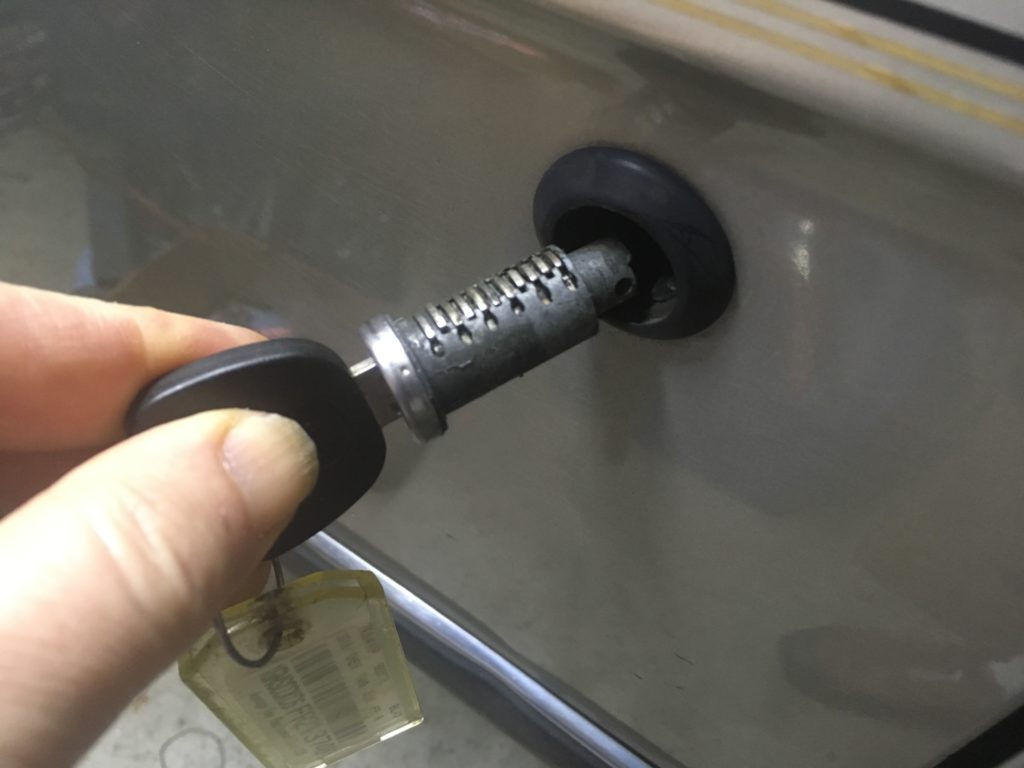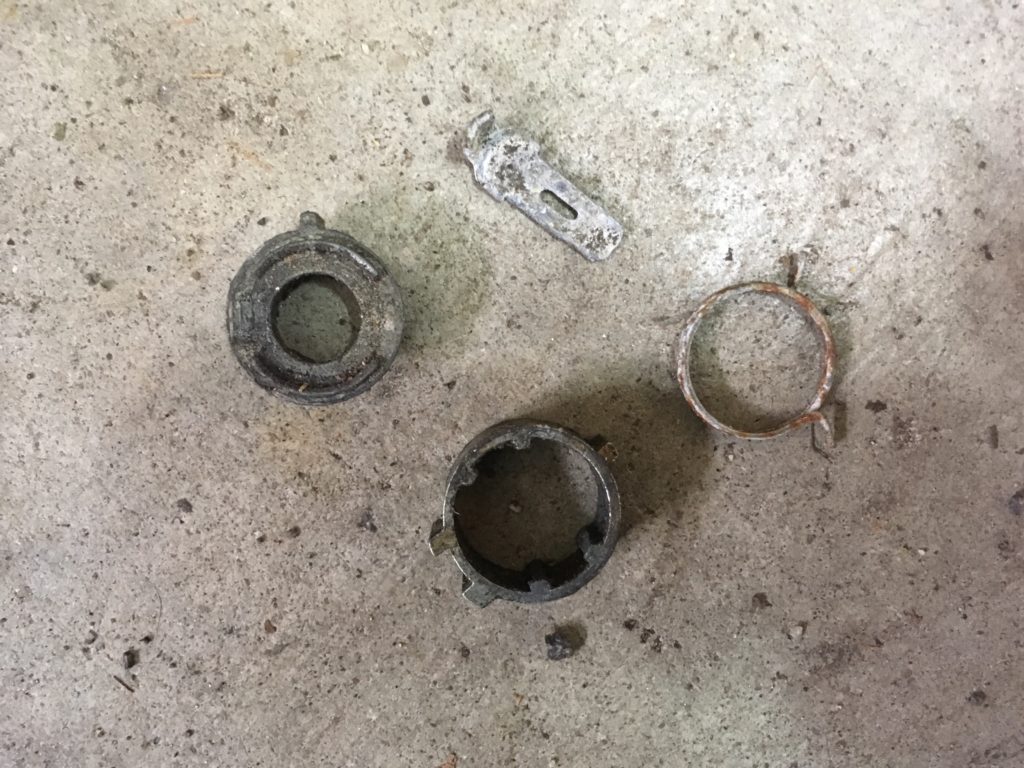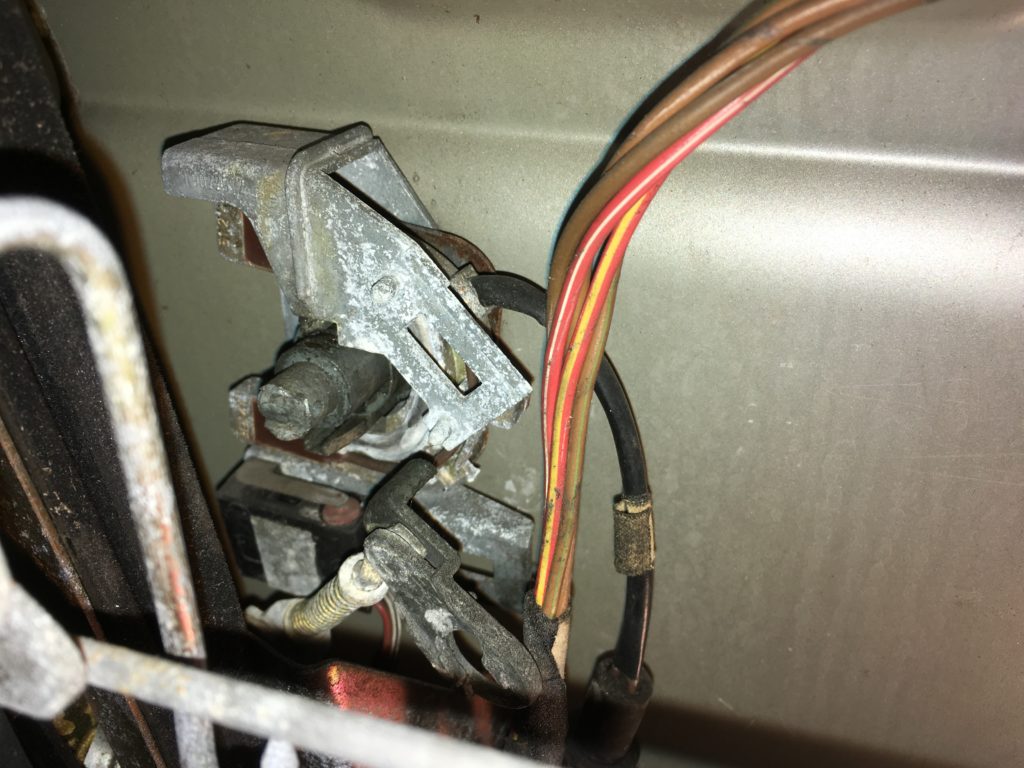Last month I reported selling the Lama (my resurrected 1987 E28 535i) to sight-unseen buyers Jim and Susan Strickland of Birmingham, Alabama. As I described here and here, my inner Boy Scout wanted to do as much as possible to ensure that the remote buyers were happy. I wasn’t as tight on garage space as I expected to be due to Louie’s not coming straight home from the BMW CCA Foundation—instead being taken in for the winter by good-guy Lance White—so this gave me time and space to try to fix one more thing on the Lama. Consequently, the car took a little extra time to fledge and fly, and remained at my house for several weeks after money and paperwork were exchanged.
As I referred to during the locked-the-keys-in-the-Lama episode, the lock cylinder on the Lama’s driver’s door was not attached to anything; it would not only self-extract when you stuck the key in it, it could be removed by simply curling your fingernails around the edges and pulling it out. I really hated the idea of the cylinder falling out during transport and the car showing up at Jim and Susan’s with a hole in the door, so I decided to pull off the door panel and have a look at why it wasn’t attached.

Even though this was disclosed during the sale, selling the car with this problem bugged me.
As anyone who has heard a banging sound in a 2002, E3, or E9 door, pulled off the panel, and found the broken doorstop inside knows, sometimes the missing parts are right there at the bottom of the door, whether they’ve loosened and fallen off, or have broken off—two distinctly different matters. I hadn’t pulled the door panel off an E28 in, well, maybe forever, but I was delighted to find that its removal is a trivial task: You remove the two Phillips screws holding the arm rest, then rotate it about the pivot attachment at the top and pull it out. Then you slide the plastic piece surrounding the door latch forward and pop it out. And that’s it; after that, you simply pop off the plastic clips holding the edges of the panel to the door. Unlike 70’s-vintage BMWs, the felt trim isn’t attached to the panel; it’s part of a separate piece that remains on the door. In a world where much of my love for pre-emissions, pre-computerized cars is directly correlated with their ease of repair, it was a joy to find that this one task was actually easier, not harder.

The door panel was off in minutes.
Of course, it all went downhill from there.
I did, as expected, find errant lock parts at the bottom of the door. Some were small enough that I needed to use a magnet to drag them out.

We’ll just put these back where they go—or so I thought.
I looked next at the pieces of the lock mechanism that were still attached to the inside of the door. It was clear that the spring-loaded lever arm with the plate on the end that’s shown hanging near the wires in the photo below needed to be attached to the slotted end of the lock cylinder.

The piece hanging at bottom center was clearly what translated the rotary motion of the lock cylinder into action.
It seemed like it should a simple puzzle, but it was surprisingly challenging to figure out. I did determine how the large, thick ring in the photo of the four pieces slid onto the back of the lock cylinder, but placement of the other pieces was less obvious.
I wanted to pull the panel off the Lama’s passenger door and look inside to see an example of how it worked, but the car was too close to the right-hand wall of the garage to get the door open, and due to fresh snowfall, it was inconvenient to open the garage and reposition the car. I looked in RealOEM for an exploded parts diagram of the door lock, and was surprised that there wasn’t one. Well, there was, but the my renegade pieces weren’t shown; it appeared that the lock cylinder, the four pieces I’d found inside the door, and the hanging lever with the spring on it were all part of a single unit—#11 in the diagram below.

Piece #11 in RealOEM’s exploded view seemed to contain all of my scattered parts.
I did some searching on myE28.com (which, for some reason, is currently down), and learned that my read of the diagram was correct. While some folks reported successfully reassembling the pieces and jury-rigging them into staying in place, the general gestalt appeared to be that if it the lock cylinder and its associated parts weren’t together as pictured, the assembly was broken, and you needed to suck it up and order the correctly-keyed assembly from the dealer.
Even though the car could be locked and unlocked through the central locking system via either the passenger door or the trunk lock, I really wanted to send the Lama into the world with a functioning driver’s door lock, or at least one that wasn’t falling out. The hole at the end of the lock cylinder needed to line up with the hole through the other cylindrical piece I found at the bottom of the door. I read that a tiny spring and ball bearing were supposed to live in those holes, but wondered if I could just put a small bolt and nut through them to hold things in place. I figured out that the small lever in the photo of the four pieces needed to go in the slot at the end of the lock cylinder, but the edges of the slot appeared to be too worn, possibly even broken off, to hold the lever in place.

The end of the lock cylinder appeared to be either broken or worn past the point of use.
I had one final idea. When I’ve had 2002s where the driver’s door wouldn’t lock but the passenger door would, it’s been trivial to pull off the door handles (one big Phillips screw and one 10-mm bolt on each), undo the screws holding in the lock cylinders, swap the cylinders, and reassemble. But on the E28, the mechanism and access to it are both more complicated: You need to unclip the sprung rod from the mechanism to which it’s attached, and as can be seen from the photo below, that’s partially occluded by a bracket that’s attached to the window mechanism.
For all these reasons, in the end, I was not successful at making the driver’s door lock work. The best I could do was put a piece of a coat hanger through the hole at the end of the cylinder to ensure that it wouldn’t fall out. This had the additional effect of affixing some of the other pieces in place so they wouldn’t get knocked around. While I was in there, I replaced the grommets on the rod that ran from the interior door handle to the lock mechanism to quiet down its annoying little rattle. If I couldn’t fix the lock, at least I could do this.

Well, at least the pieces wouldn’t fall off or rattle.
And with that, my inner Boy Scout was satisfied that he’d done his best. I told Jim Strickland he could schedule the pickup.
This past Monday, when a big auto transporter arrived on the street behind my house, I backed the Lama out of the driveway, hung three left turns, pulled off the plates, and watched as the car was loaded onto the carrier. It was the first and last time I’d driven the car since Jim agreed to buy it. (Hey, not every ending is sunsets and red wine.)
But the business-like nature of the Lama’s short final drive hid something deeper and more meaningful.
Years ago, I listened to a program on foster care in which foster parents described why they do it. I heard a woman explain, with a lot of passion, what a privilege it is to get kids fed, bathed, into their jammies, read to, and tucked into bed warm and safe, and that even if the situation is only temporary, if you can do this for a child—get them to this good clean safe cared-for place—it’s a beautiful thing. I sometimes feel that that’s the role I play with certain cars. They can’t all stay forever, but if I can take them in for a while, treat their underlying mechanical issues, and get them to the point where they can rejoin the driving world, then—although there’s no mistaking it for caring for children—I’ve done some good.
I was proud to have resurrected and cared for the Lama. I became unexpectedly attached to it, thoroughly enjoyed driving it, and already feel the Lama-shaped hole in my garage, and my existence. I look forward to hearing of its adventures with its new owners, Jim and Susan.

As Neil Young said, long may you run.
As I was sending this in, Jim messaged me, saying that the shipper informed him that the transporter carrying the Lama had broken down in New Jersey. Noting all the work I’d done on the car, Jim said, “The Lama is more mechanically sound than the truck towing it!”—Rob Siegel
Rob’s new book, Just Needs a Recharge: The Hack MechanicTM Guide to Vintage Air Conditioning, is available here on Amazon. His previous book Ran When Parked is available here. Or you can order personally inscribed copies of all of his books through Rob’s website: www.robsiegel.com.





















